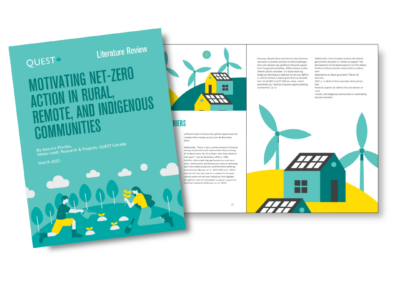Community Centre Cuts Energy Use in Half

The AYR Motor Centre in Woodstock, New Brunswick, is this Town’s single largest consumer of electricity. In fact, since opening its doors on March 17, 1995, the facility’s average draw has exceeded 3.3 million kilowatt hours annually, making it one of the hungriest buildings in Carleton county.
It’s not hard to see why. At 131,175 square feet it houses a five-lane swimming pool, hockey arena, indoor running track, fitness centre, three basketball courts, two daycares, five rental rooms and the Town’s entire recreation department. It caters to all demographics and is stubbornly accessible to the 10,000 people within driving distance. All these services demand electricity, and electricity begets carbon.
Cutting back its greenhouse gas emissions was first considered during a series of retrofits in 2015. Among the suggestions was a substantial rooftop solar array, supplying the facility directly and pouring excess electricity into the provincial grid, but this idea and others didn’t come to fruition. In the words of Kelly Foster-Hallett, Woodstock’s Director of Recreation, “the payoff just wasn’t there.”
But a lot’s changed since then, not least of which the availability of government subsidies for projects cutting carbon emissions. In 2019, Woodstock decided to revisit the issue of the AYR Motor Centre’s electricity consumption and commissioned a study to seek practical improvements.
“There were a fair number of opportunities,” said Project Manager Darren Webber.. According to their study, the centre’s electricity use could be more than halved, from its annual 3.3 million kilowatt hours down to 1.5 million, with just one more round of retrofits.
Some were obvious, like replacing the facility’s antiquated T8 fluorescent light fixtures with LEDs, but a more sophisticated solution included “demand control ventilation.” Unlike the original ventilation system, which regularly exchanged air with the outdoors regardless of conditions within, the new demand control system measures the concentration of exhaled carbon dioxide in the building and only exchanges air when necessary.
“In that way,” said Webber, “you can lessen how much fresh air you bring into the building, which means you don’t have to heat it or cool it.”

Another, more substantial retrofit was the replacement of the arena’s refrigeration plant, decades old equipment maintaining the ice on which minor and junior c hockey leagues depend. Not only was the original unit grossly inefficient by modern standards, it was designed such that the heat it removed from the arena floor was exhausted outside entirely unused. The new unit, equipped with a heat recovery system, empowers building operators to harness that waste heat and put it to use elsewhere in the building, specifically heating the pool and all domestic hot water. The amount of recovered heat is so substantial, in fact, that Webber and colleagues can’t find a use for it all. This, he fully expects, will be the subject of future projects.
Outside hockey season, when the refrigeration plant is not running and therefore generating no waste heat, the pool, domestic water and building interior are all managed with good, old-fashioned electric heating and cooling. For this, the Town revived its ambitions for solar energy. It was decided the facility’s rooftop would host a 100-kilowatt, 360 panel, grid-tied solar array, the maximum output allowed by New Brunswick Power. The AYR Motor Centre uses everything it can from these panels and shunts the remainder onto the grid in exchange for credits on its electricity bill.
These retrofits and others began in 2020 with financial support for the Federation of Canadian Municipalities and the province’s Commercial Building Retrofit Program. Work was supposed to be complete last fall, but the pandemic complicated things. Webber now expects everything to be finished this September, but is happy to report the solar array is installed and operational.
Prior to these retrofits, the Town of Woodstock took a good, long look at its contributions to climate change and decided that, by 2025, they’d like to reduce greenhouse gas emission from municipal services (public buildings, vehicles, waste management) by 410 tonnes of CO2-eq annually, a reduction just shy of 19 per cent. The ongoing reinvention of the AYR Motor Centre alone, however, is projected to eliminate over 431 tonnes annually. So, by September of this year, Woodstock will have met 105 per cent of its 2025 municipal services carbon reduction goal, all with one project.
According to the Town’s Chief Administrative Officer Ken Anthony, there may be more reductions to come. Woodstock recently entered talks with the neighbouring communities of Perth-Andover and Florenceville-Bristol to identify potential sites for future wind energy generation. There have also been conversations within the Town about feeding the AYR Motor Centre with hydroelectricity from the Saint John River, although this idea remains very theoretical. Anthony expects their recent partnership with QUEST (a national non-government organization that works to accelerate the adoption of efficient and integrated community-scale energy systems in Canada) through their New Brunswick Smart Energy Communities Accelerator Program to help clarify these opportunities and illuminate others altogether, but until the way forward is clear, the AYR Motor Centre remains Woodstock’s centrepiece of climate action.
“The only thing more impressive than this building,” said Anthony, “is the people who operate it.”
Aside from frustrating retrofits, the Covid-19 pandemic has imbued the AYR Motor Centre with a new purpose – to maintain the physical and mental health of regional residents in ways no other public building can.
Like so many others across Atlantic Canada, this facility closed its doors hastily in March of 2020, but according to Kelly Foster-Hallett, they reopened the following April with a battery of public safety protocols in order that residents, suddenly trapped at home, could still partake in much needed recreation, using the AYR Motor Centre’s prodigious space to maintain social distancing and respect occupancy limits. They played this role so well that several school programs, especially grade school basketball, found new life in their facility in spite of the pandemic. In a bit of narrative symmetry, the centre now supports one of Woodstock’s major vaccination clinics.
“We always say that Covid’s a reason not to do anything,” said Foster-Hallett, “but [it’s] not a reason to do nothing.”
ABOUT THE AUTHOR

Zack Metcalfe

About Powered by Communities
Established in 2017, Powered by Communities is an awareness-raising, communications and media platform that highlights and celebrates local community energy initiatives taking place across the country, from coast to coast to coast. The platform inspires, informs and engages its readership with stories and articles detailing community energy initiatives being led by local governments, municipalities, Indigenous communities, community groups, non-profits, charities, and enterprising individuals.

About QUEST Canada
QUEST Canada is a national non-profit that supports communities in Canada on their pathway to net-zero. Since 2007, we’ve been facilitating connections, empowering community champions and influencing decision-makers to implement efficient and integrated energy systems that best meet community needs and maximize local opportunities. We develop tools and resources, convene stakeholders and rights holders and advise decision-makers — all with the goal of encouraging and enabling communities to contribute to Canada’s net-zero goals.

Support local communities by sharing this story
MORE FROM POWERED BY COMMUNITIES
Sign Up
Join the Conversation!
Sign up to get the latest news and updates about QUEST Canada events and receive QUEST Canada's monthly newsletter.




